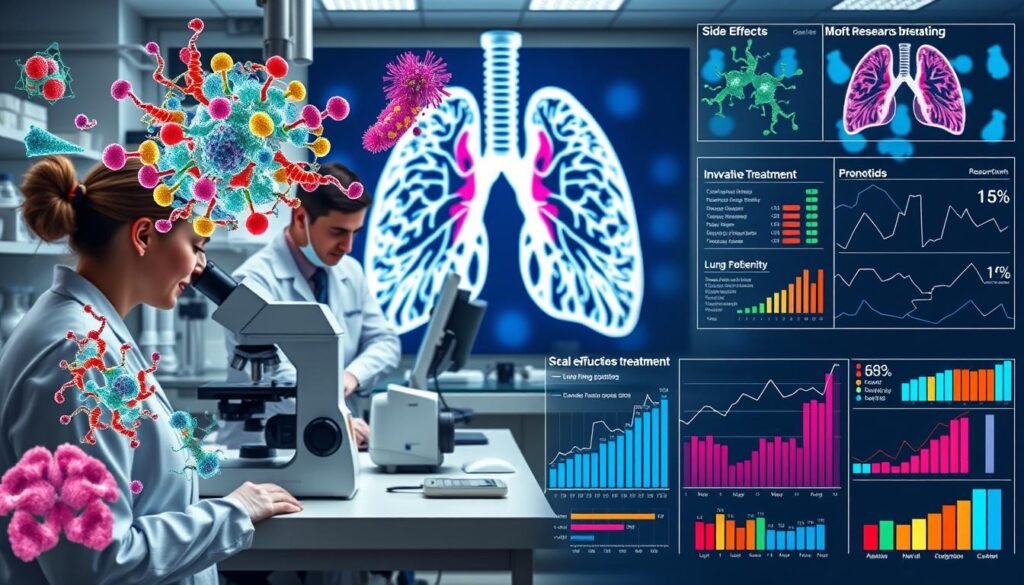Did you know about 70% of lung cancer patients face tough side effects? It’s key to know these issues when dealing with lung cancer. Treatments like chemo, targeted therapies, and radiation bring challenges. Patients often deal with nausea, feeling very tired, and emotional ups and downs.
This article shines a light on lung cancer treatment’s side effects. We aim to help patients and their families navigate managing these effects. It’s about making the journey a bit easier for everyone involved.
Key Takeaways
- Understanding various lung cancer treatments helps anticipate potential side effects.
- Coping with symptoms like nausea and fatigue is crucial for quality of life.
- Open communication with healthcare providers enhances treatment management.
- Support systems, including counseling and nutrition planning, can alleviate treatment discomfort.
- Being proactive in side effect management can lead to better treatment outcomes.
Understanding Lung Cancer Treatments
Lung cancer treatments are key in managing the disease. They offer many options based on the patient’s needs. Treatments like surgery, radiation therapy, chemotherapy, targeted therapies, and immunotherapy are common. They aim to kill cancer cells but spare healthy tissues.
Surgery is a top choice for early-stage non-small cell lung cancer. It might remove parts or all of the lung. After surgery, patients can face pain, coughing, and tiredness. Knowing what to expect helps patients manage their recovery.
Chemotherapy works against both NSCLC and small cell lung cancer. It often goes in through veins. Side effects include losing hair, feeling sick, and being very tired. Learning about these side effects is important.
Targeted therapy attacks cancer cells with specific genetic changes. It might cause skin problems and blood pressure changes. Immunotherapy, a new option, teaches the immune system to fight cancer. Yet, it also has side effects like tiredness and skin rash.
Radiation therapy is another method that can be used alone or with surgery. It might cause swallowing troubles, coughing, and feeling tired. The side effects depend on the treatment spot and the patient.
| Type of Treatment | Common Side Effects |
|---|---|
| Surgery | Pain, cough, shortness of breath, fatigue |
| Chemotherapy | Nausea, hair loss, fatigue, mouth sores |
| Targeted Therapy | Skin problems, high blood pressure, bleeding issues |
| Immunotherapy | Fatigue, rash, diarrhea, nausea |
| Radiation Therapy | Shortness of breath, cough, fatigue, difficulty swallowing |
Understanding lung cancer treatment options is crucial for patients. It helps make informed choices in their care. Knowing about treatments and side effects aids in discussing care plans with doctors, ensuring a more personalized approach.
Side Effects of Lung Cancer Treatment
Dealing with lung cancer treatment side effects is tough. Knowing about these effects is key for managing them well. These side effects can disrupt everyday life.
Common Side Effects Overview
Several side effects are common:
- Nausea
- Fatigue
- Hair loss
- Skin irritation
- Coughing
Side effects vary with the treatment method. Treatments might include surgery, chemotherapy, radiation, or targeted therapies. Some side effects happen right away, others might appear later.
Temporary vs. Long-term Side Effects
Side effects can be short-lived or last a long time. Short-term ones usually go away after the treatment ends. For example, hair loss and fatigue fade as you recover.
But some effects, like neuropathy and heart problems, can linger. These might seem daunting. Talking with your doctor and making a plan can help manage them.
Check out this detailed guide for more on treatments and side effects.
| Type of Side Effect | Examples | Duration |
|---|---|---|
| Temporary Side Effects | Nausea, Fatigue, Hair Loss | Shortly after treatment |
| Long-term Side Effects | Neuropathy, Cardiac Issues | Extended period post-treatment |
Common Side Effects of Lung Cancer Treatment
Lung cancer treatments often improve outcomes but carry side effects. Knowing these effects is key for patient care. Treatments like chemotherapy, targeted therapy, and radiation can impact daily life differently. It’s important to recognize and address these impacts quickly.
Chemotherapy Side Effects
Chemotherapy is a common lung cancer treatment. It mainly treats non-small cell lung cancer (NSCLC) using drug combinations. This can cause several chemotherapy side effects, such as:
- Nausea and vomiting
- Fatigue
- Hair loss
- Diarrhea
- Increased risk of infection
Talking early with healthcare providers can ease these effects. For more on managing chemotherapy effects, visit this resource.
Targeted Therapy Side Effects
Targeted therapies attack cancer cells with less harm to normal cells. But, targeted therapy side effects can still happen. Common ones include:
- Nausea
- Skin rashes
- Swelling
- Fatigue
Keeping in touch with your medical team can help manage these effects well.
Radiation Therapy Side Effects
Radiation therapy might be used alone or with other treatments. It depends on the lung cancer’s type and stage. This treatment often leads to radiation therapy side effects, like:
- Mucosal irritation, which makes swallowing hard
- Skin changes in the treated area
- Persistent fatigue
It’s crucial to deal with these effects fast. This helps keep a good quality of life during treatment. Knowing the challenges of each therapy helps patients better handle their treatment and well-being.
Managing Side Effects of Lung Cancer Treatment
It’s key to manage side effects to better patients’ lives. Using both palliative care and good communication with doctors is vital. This way, healthcare teams can reduce discomfort and improve day-to-day life.
Palliative Care for Symptom Management
Palliative care is vital for easing chronic symptoms of lung cancer treatment. It aims to lessen pain, nausea, and tiredness caused by treatments like chemo and radiation. Recognizing these symptoms lets teams provide personalized care to improve life quality. Methods such as controlling pain, changing diets, and physical therapy are central to this care approach.
Importance of Communication with Healthcare Providers
Open talks with healthcare providers greatly improve side effects management. Patients need to freely share their symptoms. This ensures quick and effective adjustments to treatment and support. Regularly talking about changes in symptoms allows for better care and support from healthcare teams.

Ways to Cope with Lung Cancer Treatment Side Effects
Dealing with lung cancer treatment side effects requires understanding and patience. Those undergoing treatment face many emotional and physical challenges. It’s key to find effective coping strategies. Doing so can greatly improve one’s quality of life. It helps patients manage their cancer journey better.
Emotional Support and Counseling
Getting emotional support is crucial. It helps with the mental stress of lung cancer. Talking with others in counseling or support groups is helpful. You realize you’re not alone. This bond builds strength and gives a sense of community in uncertain times. Emotional support reduces loneliness. It also helps find ways to deal with tough feelings.
Nutrition and Diet Adjustments
Changing your diet helps with treatment side effects like nausea and losing appetite. Eating small meals throughout the day keeps your energy up. It also makes digestion easier. Picking foods full of nutrients and drinking nutritious liquids are good choices. Paying attention to what you eat helps with recovery. It gives your body the strength it needs.
Physical Activity and Rest
Keeping a balance of exercise and rest is important. Light exercise can lessen tiredness and lift your spirits. This makes everyday tasks easier. Making time for rest helps your body heal. Good sleep habits are important for your health during this tough time.
Preventing Side Effects of Lung Cancer Treatment
Treating lung cancer effectively often means dealing with side effects. These can impact your daily life. Pre-treatment consultations with doctors are key. They let you talk about side effects and look at ways to prevent them. This is tailored to what you need.
Pre-treatment Consultations
Pre-treatment meetings are key in spotting issues that might come up with lung cancer treatment. By talking with doctors, you learn about possible side effects. You discuss therapies for non-small cell lung cancer (NSCLC) and small cell lung cancer (SCLC). This helps make a plan that’s just for you to prevent side effects of lung cancer treatment.
Having open chats can help you know what to expect. It can make it easier to handle how you feel during your treatment. Learn more about important questions to ask your doctor here.
Preventative Strategies During Treatment
There are many ways to lessen side effects while being treated.
- Eat more fruits and vegetables to help lower your cancer risk and build your immune system.
- Drink plenty of water. It helps with tiredness and makes you feel better overall.
- Stay active to help your mood and reduce tiredness and worry.
- Have a support network for emotional help and better coping skills.
By doing these things, patients can have more control over their treatment. It builds strength and hope. Focusing on good habits and talking well with doctors can really help lower the effects of treatment.

Coping Strategies for Lung Cancer Treatment Side Effects
Lung cancer treatment can lead to emotional and physical challenges. It’s common to feel distressed after a diagnosis. Using coping strategies is key for emotional balance and well-being during treatment.
Relaxation Techniques
Relaxation methods help manage anxiety and stress. Techniques like deep breathing, progressive muscle relaxation, and guided imagery reduce tension. They promote peace. Mindfulness and exercises like walking or yoga also help with symptoms and lung health.
Support Groups and Resources
Participating in support groups allows emotional connections with others in similar situations. The Lung Cancer Survivors Community on Inspire offers resources and shared stories to uplift spirits. These interactions create a sense of belonging and understanding. Furthermore, therapists experienced with serious illnesses can offer customized support. Embracing one’s emotions and reaching out to support groups boosts emotional strength.
Severe Side Effects of Lung Cancer Treatment
Lung cancer treatments can have tough side effects. These can really affect a patient’s health and happiness. It’s key to know these effects and get help fast to manage them well.
When to Seek Immediate Medical Attention
Some severe side effects of lung cancer treatment are:
- Difficulty breathing: Trouble breathing calls for immediate doctor visits.
- Extreme fatigue: A sudden increase in tiredness can mean big problems.
- Chest pain: Chest discomfort needs quick check-ups for safety.
- Signs of infection: Fever or confusion means it’s doctor time.
- Deep vein thrombosis: Swelling or limb pain? See a doctor fast.
Quick medical help is key to prevent worse problems, make treatments work better, and keep patients safe.
Long-term Monitoring for Side Effects
After treatment ends, long-term monitoring starts. It keeps an eye on lasting side effects. Watching out for health changes is a big part of this stage.
- Respiratory health: Lung health checks are a must after treatment.
- Cardiovascular health: Heart checks are crucial for some therapy types.
- Skin conditions: Skin care is important due to possible reactions.
- Nutrition and weight management: Good food helps manage appetite and weight issues.
Working closely with doctors during recovery helps spot and manage any new symptoms. This can greatly reduce risks linked to unchecked problems.
Symptoms of Lung Cancer Treatment Side Effects
Knowing the side effects of lung cancer treatment helps in managing health better. Early spotting of symptoms can greatly help in talking effectively with doctors. This can lead to better treatment results. Key signs like often coughing, feeling short of breath, and eating less are important to notice early.
Recognizing Early Warning Signs
People getting lung cancer treatment need to watch for different symptoms. These include:
- Persistent cough that does not improve
- Coughing up blood
- Chest pain that may worsen with deep breaths or coughing
- Hoarseness or changes in voice
- Loss of appetite and subsequent weight loss
- Shortness of breath or wheezing
- Unexplained fatigue or weakness
- Recurring infections or pneumonia
- Bone pain, particularly if it worsens
Even if these symptoms might be caused by other issues, seeing a doctor quickly is important for effective care.
Documenting Side Effects for Healthcare Discussions
Keeping track of side effects during lung cancer treatment is very helpful for doctors. A detailed record shows how symptoms change, helping to adjust treatments. Patients should note:
- Date and time when a symptom starts
- What each symptom is like and how bad it is
- Things like diet or activity that might relate
- How any treatments or medicines work
This record makes it easier to talk openly with doctors, ensuring treatments meet the patient’s needs. Staying engaged in tracking symptoms supports better health results.
Research and Innovations in Managing Side Effects
Research on lung cancer side effects is improving patients’ quality of life. Scientists are creating new drugs and therapies for treatment symptoms. For example, a program called SAMI helps with pain and mental health.
This approach has made it easier for patients to handle pain, fatigue, and worry.

Treatment isn’t just about medication anymore. Things like counseling are being used to help with the stress of cancer. Doctors are working together to bring these new options to patients.
In the U.S., not many people at risk get checked for lung cancer. Educating people and reaching out are key. This research highlights the need for better screening and care for those at risk.
Finding new ways to manage symptoms is important for cancer treatment. These discoveries aim to ease the struggle of those fighting lung cancer.
Conclusion
Handling the side effects of lung cancer treatment improves patients’ lives. A detailed look shows almost all patients face at least one side effect. Fatigue hits 87% of them the hardest. Loss of appetite and diarrhea are common too, showing the need for good management plans.
It’s crucial to know how to manage these side effects. Patients should talk openly with their doctors to tweak treatments as needed. Also, changing what you eat and joining support groups help ease the journey’s stress.
In short, dealing with lung cancer side effects needs a careful mix of professional advice, self-care, and support networks. With more awareness, tools like effective treatment information help patients stay strong and make smart choices during their treatment.